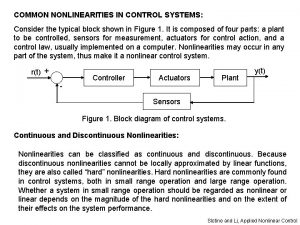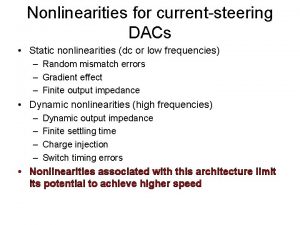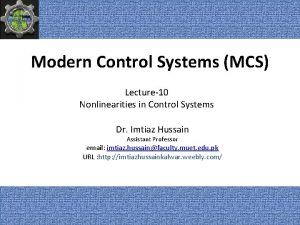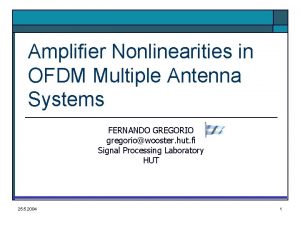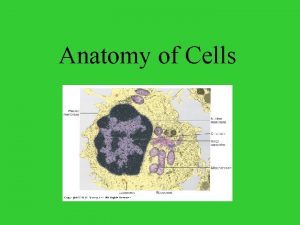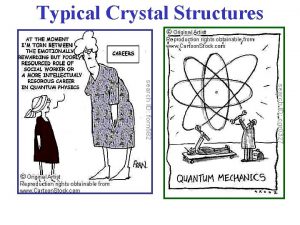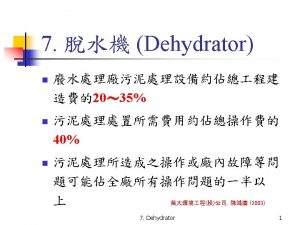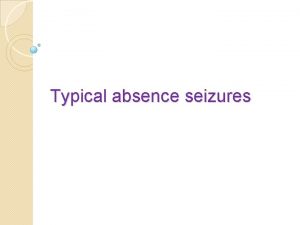COMMON NONLINEARITIES IN CONTROL SYSTEMS Consider the typical
















- Slides: 16

COMMON NONLINEARITIES IN CONTROL SYSTEMS: Consider the typical block shown in Figure 1. It is composed of four parts: a plant to be controlled, sensors for measurement, actuators for control action, and a control low, usually implemented on a computer. Nonlinearities may occur in any part of the system, thus make it a nonlinear control system. r(t) + - Controller Actuators Plant y(t) Sensors Figure 1. Block diagram of control systems. Continuous and Discontinuous Nonlinearities: Nonlinearities can be classified as continuous and discontinuous. Because discontinuous nonlinearities cannot be locally approximated by linear functions, they are also called “hard” nonlinearities. Hard nonlinearities are commonly found in control systems, both in small range operation and large range operation. Whether a system in small range operation should be regarded as nonlinear or linear depends on the magnitude of the hard nonlinearities and on the extent of their effects on the system performance. Slotine and Li, Applied Nonlinear Control

Saturation: When one increases the input to a physical device, the following phenomenon is often observed: when the input is small, its increase leads to a corresponding (often proportional) increase of output: but when the input reaches a certain level, its further increase does produce little or no increase of the output. The output simply stays around its maximum value. The device is said to be saturation when this happen. A typical saturation nonlinearity is represented in Figure 2, where thick line is the real nonlinearity and the thin line is an idealized saturation nonlinearity. Figure 2. A saturation nonlinearity. Most actuators display saturation characteristics. For example, the output torque of a two-phase servo motor cannot increase infinitely and tends to saturate, due to the properties of magnetic material.

The input-output relationship for a saturation nonlinearity is plotted in Figure 3, with a and k denoting the range and slope of the linearity. Since this nonlinearity is single-valued, we expect the describing function to be a real function of the input amplitude. Figure 3. Saturation nonlinearity and the corresponding input-output relationship.

Consider the input x(t)=Asin(ωt). If A≤a, then the input remains in the linear range, and therefore, the output is w(t)=k. Asin(ωt). Hence, the describing function is simply a constant k. Consider the case A>a. The input and the output functions are plotted in Figure 3. The output is seen to be symmetric over the four quarters of a period. In the first quarter, it can be expressed as where γ=sin-1(a/A). The odd nature of w(t) implies that a 1=0 and the symmetry over the four quarters of a period implies that Therefore, the describing function is

The normalized describing function N(A)/k is plotted in Figure 4 as a function of A/a. One can observe three features for this describing function. 1. N(A)=k if the input amplitude is in the linearity range 2. N(A) decreases as the input amplitude increases 3. There is no phase shift N(A)/k 1 0. 8 0. 6 0. 4 0. 2 0 1 5 10 A/a Figure 4. Describing function of the saturation nonlinearity Slotine and Li, Applied Nonlinear Control

Relay Nonlinearity: As a special case, one can obtain the describing function for the relay-type (on-off) nonlinearity shown in Figure 5. This case corresponds to shrinking the linearity range in the saturation function to zero, i. e. , a 0, k ∞, but ka=M. b 1 can be easily obtained directly as Therefore, the describing function of the relay nonlinearity is N(A)/M to infinity 1 w M 0. 8 on 0. 6 x 0 0. 2 0 -M off to zero 0. 4 1 5 10 Figure 5. Describing function of the relay nonlinearity A

Dead-Zone: Consider the dead-zone characteristics shown in Figure 6, with the dead-zone with being 2δ and its slope k w -δ δ x dead-zone Figure 6. A dead-zone nonlinearity. Dead-zones can have a number of possible effects on control systems. Their most common effect is to decrease static output accuracy. They may also lead to limit cycles or system instability because of the lack of response in the deadzone. The response corresponding to a sinusoidal input x(t)=Asin(ωt) into a dead-zone of width 2δ and slope k, with A≥δ, is plotted in Figure 7. Since the characteristics is an odd function, a 1=0. The response is also seen to be symmetric over the four quarters of a period. In one quarter of a period, i. e. , when 0≤ωt≤p/2, one has Slotine and Li, Applied Nonlinear Control

x(t) Figure 7. Input and output functions for a dead-zone nonlinearity. Slotine and Li, Applied Nonlinear Control

where The coefficient b 1 can be computed as follows

This describing function N(A) is a real function and, therefore, there is no phase shift (reflecting the absence of time-delay). The normalized describing function is plotted in Figure 8. It is seen that N(A)/k is zero when A/d<1, and increases up to 1 with A/d. This incraese indicates that the effect of the dead-zone gradually diminishes as the amplitude of the signal is increased, consistently with intuition. N(A)/k 1 0. 8 0. 6 dead-zone converging to 1 0. 4 0. 2 0 1 5 10 A/d Figure 8. Describing function of the dead-zone nonlinearity. Slotine and Li, Applied Nonlinear Control

Backlash: Backlash often occurs in transmission systems. It is caused by the small gaps which exist in transmission mechanism. In gear trains, there always exists small gaps between a pair of mating gears as shown in Figure 9. output angle -b D C B O A b slope 1 input angle E Figure 9. A backlash nonlinearity. The backlash occurs as result of the unavoidable errors in manufacturing and assembly. As a results of the gaps, when the driving gear rotates a smaller angle than the gap b, the driven gear does not move at all, which corresponds to the dead zone (OA segment); after contact has been established between the two gears, the driven gear follows the rotation of the driving gear in a liner fashion (AB segment). When the driving gear rotates in the reverse direction by a distance of 2 b, the driven gear again does not move, corresponding the BC segment.

After the contact between the two gears is re-established, the driven gear follows the rotation of the driving gear in the reverse direction (CD segment). Therefore, if the driving gear is in periodic motion, the driven gear will move in the fashion represented by the closed loop EBCD. Note that the height of B, C, D, E in the figure depends on the amplitude of the input sinusoidal. Figure 10 shows a backlash nonlinearity, with slope k and width 2 b. If the input amplitude is smaller then b, there is no output. Consider the input being x(t)=Asin(ωt), A≥b. The output w(t) of the nonlinearity is as shown in the figure. In one cycle, the function w(t) can be represented as where Figure 10. Backlash nonlinearity. Slotine and Li, Applied Nonlinear Control

Unlike the other nonlinearities, the function w(t) here is neither odd nor even. Therefore, a 1 and b 1 are both nonzero. Therefore, the describing function of the backlash is given by The amplitude of the describing function for backlash is plotted in Figure 11. Slotine and Li, Applied Nonlinear Control

Angle(N(A)) 1. 0 0 0. 8 -20 0. 6 -40 0. 4 -60 0. 2 -80 0 0. 2 0. 4 0. 6 0. 8 1. 0 b/A -90 0. 2 0. 4 0. 6 0. 8 1. 0 b/A Figure 11. Aplitude and phase angle of describing function for backlash. Unlike the previous nonlinearities, a phase angle is introduced by backlash. The phase lag is the reflection of the time delay of the backlash, which is due to the gap b. Of course, a larger b leads to a larger phase lag, which may create stability problems in feedback control systems. Slotine and Li, Applied Nonlinear Control

w Example: Consider the plant 1 with relay nonlinearity x 0 -1 off T 1=3, T 2=2, K=2, M=1, r(t)=3. 05 u(t) on

Construct the Simulink model including relay nonlinearity and observe the response. Limit cycle occurs
 Lcm of 12 and 18
Lcm of 12 and 18 Common anode and common cathode
Common anode and common cathode Factors of 72
Factors of 72 Lowest common factor
Lowest common factor Lcm of 16 24 and 40
Lcm of 16 24 and 40 Multiples of 9 and 21
Multiples of 9 and 21 Hình ảnh bộ gõ cơ thể búng tay
Hình ảnh bộ gõ cơ thể búng tay Ng-html
Ng-html Bổ thể
Bổ thể Tỉ lệ cơ thể trẻ em
Tỉ lệ cơ thể trẻ em Voi kéo gỗ như thế nào
Voi kéo gỗ như thế nào Glasgow thang điểm
Glasgow thang điểm Chúa yêu trần thế alleluia
Chúa yêu trần thế alleluia Các môn thể thao bắt đầu bằng tiếng đua
Các môn thể thao bắt đầu bằng tiếng đua Thế nào là hệ số cao nhất
Thế nào là hệ số cao nhất Các châu lục và đại dương trên thế giới
Các châu lục và đại dương trên thế giới Công thức tiính động năng
Công thức tiính động năng

















